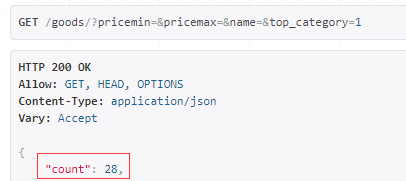8- vue django restful framework 打造生鲜超市 -商品类别数据展示(下)
Vue+Django REST framework实战
搭建一个前后端分离的生鲜超市网站
Django rtf 完成 商品类别页
vue展示商品列表页数据
- 点击某一个导航的一级类,将数据显示出来。或点击搜索,搜索出结果
这两个功能要一起完成: 格局是一样的,左侧导航,右侧商品列表。
点击某一个导航分类会显示它底下的二级三级分类,一级它有多少商品。
搜索只会显示一级与二级分类。
商品列表页有他的分页和排序。
当我们点击生鲜食品和搜索都用的是同一个左侧nav组件。但是它又有所区别
点击搜索,它请求的是所有的category显示到二级目录,而点击生鲜食品。它只请求当前类别下的二级和三级目录。
如何才能在一个组件中区别出世导航栏过来的,还是搜索页面过来的。
在head里面就能找到这两者vue router的区别。
可以看到不管是通过点击弹出的还是导航都是跳转到上图所示的vue router
点击热搜榜则跳转的是search router
- 查看vue router里面的跳转逻辑
src/router/index.js
list为商品分类,而search为搜索
可以看出component指向同一个组件。只是url不一样。当然url附带的参数也不一样;
一个是id 一个是keyword
src/views/list/list.vue 中
在页面生命周期的create方法中进行了getalldata的调用:
created () {
this.getAllData ();
},
getAllData中我们可以获取到this.$route.params虽然共用的是一个组件,但是路径里传的参数不同。
getAllData () {
console.log(this.$route.params)
if(this.$route.params.id){
this.top_category = this.$route.params.id;
this.getMenu(this.top_category); // 获取左侧菜单列表
}else{
this.getMenu(null); // 获取左侧菜单列表
this.pageType = 'search'
this.searchWord = this.$route.params.keyword;
}
this.getCurLoc(); // 获取当前位置
this.getListData(); //获取产品列表
this.getPriceRange(); // 获取价格区间
},
如果传过来的是id,那么会是上面代码中的getMenu,传入当前的category的id作为参数。
获取到某一个category的二级三级分类。
getMenu(id) {
if(id != null){
getCategory({
id:this.$route.params.id
}).then((response)=> {
this.cateMenu = response.data.sub_cat;
this.currentCategoryName = response.data.name
}).catch(function (error) {
console.log(error);
});
}else {
getCategory({}).then((response)=> {
this.cateMenu = response.data;
this.isObject = false
}).catch(function (error) {
console.log(error);
});
}
},
如果id不为空,也就是分类查询二级三级,那么则调用getCategory,将当前的cateMenu和currentCategoryName 使用response.data中的进行填充。
src/views/list/list-nav/listNav.vue:
可以看到传递进来的参数,我们是在list中获取到的数据想要传递到listnav中来,就要用
通过冒号后面加变量及参数名。将当前页内值传递到list_nav.因为不止要获得类别,还要获取商品一共多少件。
左侧的列表调用的都是getCategory函数,之前我们已经将其配置为本地化数据。
商品的列表页
获取产品的列表会判断我们是只几天的search。还是要获取商品getGoods
getListData() {
if(this.pageType=='search'){
getGoods({
search: this.searchWord, //搜索关键词
}).then((response)=> {
this.listData = response.data.results;
this.proNum = response.data.count;
}).catch(function (error) {
console.log(error);
});
}else {
getGoods({
page: this.curPage, //当前页码
top_category: this.top_category, //商品类型
ordering: this.ordering, //排序类型
pricemin: this.pricemin, //价格最低 默认为‘’ 即为不选价格区间
pricemax: this.pricemax // 价格最高 默认为‘’
}).then((response)=> {
this.listData = response.data.results;
this.proNum = response.data.count;
}).catch(function (error) {
console.log(error);
});
}
},
搜索的时候不需要知道当前的页码,排序规则。而如果page_type不是搜索(page_type的设定是位于getalldata中根据请求参数判断设定的),那么我们可以调用getGoods
getGoods位于api.js中
//获取商品列表
export const getGoods = params => { return axios.get(`${local_host}/goods/`, { params: params }) }
getListData中的getgoods可以看到前端使用的参数名称。
我们可以前往view中将分页的参数修改为page与前端保持一致。
page_query_param = "page"
参数top_category就是我们的第一级别。它是将我们参数中的id值传入。
因此在后台我们也需要配套的做一个category的过滤器。
如何获取一级分类下的所有商品。
goods/filters.py:class GoodsFilter
top_category = filters.NumberFilter(name="category",method='top_category_filter')
def top_category_filter(self, queryset, name, value):
# 不管当前点击的是一级目录二级目录还是三级目录。
return queryset.filter(Q(category_id=value)|Q(category__parent_category_id=value)|Q(category__parent_category__parent_category_id=value))
然后将queryset return回去。
pricemin以及pricemax与我们的前端代码中的不一致。
所以修改goods/filters.py中的与前端保持一致。
分页数据中会自带一个count值。
往上翻一点; getListdata中的getGoods里面我们获取到了response.data.count;
然后存入了proNum中。proNum是我们当前页面data中的变量,通过list nav:传递到了list nav页面
list sort也是同样传递了这个变量过去。
- 设置分页size与前端保持一致
class GoodsPagination(PageNumberPagination):
page_size = 12
- GoodsListViewSet中的order字段与前端保持一致
ordering_fields = ('sold_num', 'shop_price')
vue的商品搜索功能
search_fields = ('name', 'goods_brief', 'goods_desc')
没有需要配置的接口,因为search仍然调用的是后端的goods接口。
价格区间
为price-range组件传递了priceRange参数
getPriceRange () {
this.$http.post('/priceRange', {
params: {
proType: this.type, //商品类型
}
}).then((response)=> {
this.priceRange = response.data;
}).catch(function (error) {
console.log(error);
});
},
getPriceRange会在getAllData也就是crate生命周期被调用。
$http.post是发起向mock中的数据接口的请求。
Mock.mock('/priceRange',
推荐将这些数据设置到后台中。价格区间根据不同的商品类别等计算。



